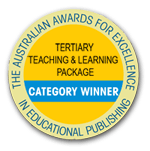 <a onClick="window.open('/olcweb/cgi/pluginpop.cgi?it=gif::::/sites/dl/free/0074716581/381452/AWARDS_cover_flash_mcshane.gif','popWin', 'width=NaN,height=NaN,resizable,scrollbars');" href="#"><img valign="absmiddle" height="16" width="16" border="0" src="/olcweb/styles/shared/linkicons/image.gif"> (11.0K)</a> <a onClick="window.open('/olcweb/cgi/pluginpop.cgi?it=gif::::/sites/dl/free/0074716581/381452/AWARDS_cover_flash_mcshane.gif','popWin', 'width=NaN,height=NaN,resizable,scrollbars');" href="#"><img valign="absmiddle" height="16" width="16" border="0" src="/olcweb/styles/shared/linkicons/image.gif"> (11.0K)</a> | Winner: Tertiary (Wholly Australian) Teaching and Learning Package Category Winner.The Australian Awards for Excellence in Educational Publishing 2007 |
ORGANISATIONAL BEHAVIOUR ON THE PACIFIC RIM, 2ND EDITION, is written around three important philosophies that we believe create a refreshing change in organisational behaviour reading: (1) Pacific Rim context; (2) contemporary issues and trends in OB; and (3) active learning. This book is written with the view that OB is relevant for everyone in organisations, not just managers. Everyone who works in and around organisations needs to understand and make use of organisational behaviour knowledge. This book helps everyone to make sense of organisational behaviour, and provides the tools to work more effectively in the workplace.
Pacific Rim Content
Organisational Behaviour on the Pacific Rim, 2nd edition, is written completely in the Pacific Rim region by authors who live and work here. This Pacific Rim orientation is most apparent in the numerous real-life anecdotes spread throughout this book. For example, the book describes the creativity of employees at Rising Sun Pictures in Adelaide, how Pretoria Portland Cement has become one of the best places to work in South Africa, how a skunkworks team at GM Holden in Melbourne catapulted the car maker’s reputation as a designer of new vehicles, how management at Kowloon Shangri-La Hotel in Hong Kong directly communicates with all staff, how Cocoplans in the Philippines strengthens employee performance through positive selffulfilling prophecies, and how ASB Bank in New Zealand strengthened employee engagement to become one of the best-performing financial institutions in the region.
Without losing its Pacific Rim focus, Organisational Behaviour on the Pacific Rim, 2nd edition, also serves up plenty of examples from around the planet. For instance, readers will learn how Dubai’s Department of Development identified its core values and taught employees how to apply those values at work, how Exxon Mobil’s Fawley plant in the UK applied behaviour modification to improve safety, how Mayo Clinic in the United States brought in an anthropologist to decipher its corporate culture, why employees at Semco in Brazil have incredibly high levels of empowerment, and how Canadian Tire introduced appreciative inquiry to bring about positive change among its retail staff.
Contemporary Concepts and Trends in OB
Every chapter of Organisational Behaviour on the Pacific Rim, 2nd edition, is built on dozens of articles, books, and other sources from diverse sources. You can see this in the references. The most recent literature receives solid coverage, resulting in what we believe is the most upto- date organisational behaviour textbook available. These references also reveal that we reach out for emerging OB concepts in information systems, marketing, and other disciplines. At the same time, this textbook is written for students, not the scholars whose work is cited. So, while this book provides new knowledge and its practical implications, you won’t find detailed summaries of specific research studies. Also, this textbook rarely names specific researchers and their university affiliations; instead, it focuses on organisational behaviour knowledge rather than ‘who’s-who’ in the field.
Organisational Behaviour on the Pacific Rim, 2nd edition, also keeps students on the crest of knowledge by discussing several emerging workplace issues. For example, the previous edition of this book was the first to introduce social identity theory, appreciative inquiry, Schwartz’s values model, the effects of job satisfaction on customer service, learning orientation, future search events, workaholism, bicultural audits, and several other groundbreaking topics. This edition continues its mandate to offer emerging OB knowledge by introducing new information on several topics, such as employee engagement, four-drive theory, resilience, communication blogs and wikis, psychological harassment, separating socioemotional conflict from constructive conflict, Goleman’s emotional intelligence model, and the automaticity and emotionality of the perceptual process.
The role of emotions now dominates many organisational behaviour studies, and this emerging knowledge is integrated throughout Organisational Behaviour on the Pacific Rim, 2nd edition. In particular, readers will learn how emotions influence perceptions (Chapter 3), attitudes (Chapter 4), employee motivation (Chapter 5), decision making (Chapter 8) and conflict (Chapter 13). The effects of globalisation as well as the relevance of knowledge management in organisational behaviour are also highlighted throughout this book.
Active Learning
In this era of active learning, critical thinking, and outcomes-based teaching, Organisational Behaviour on the Pacific Rim, 2nd edition, offers valuable resources to aid student learning. Every chapter includes at least one short case that challenges students to diagnose issues and apply ideas from that chapter. Several comprehensive cases also appear at the end of the book. Several of these cases are written by instructors around the Pacific Rim and relate to companies in this region.
Along with case studies, Organisational Behaviour on the Pacific Rim, 2nd edition, supports active learning with one or two engaging team, web, or class activities in every chapter. Many of these learning activities are not available in other organisational behaviour textbooks, such as Where in the World are We? (Chapter 8) and the Cross-Cultural Communication Game (Chapter 11). This edition also has nearly three dozen self-assessments. Self-assessments personalise the meaning of several organisational behaviour concepts, such as resilience, self-leadership, guanxi orientation, empathy, creative disposition, and corporate culture preferences.
We also have a strong commitment to the philosophy of linking theory with practice, which is also essential for active learning. By connecting concepts with real-life examples, students are more likely to remember the content and see how it relates to the real world. And, quite frankly, including these examples makes the content even more interesting, thereby motivating students to read on. This engaging approach is further strengthened through several video segments which highlight specific organisations on a variety of organisational behaviour topics.
|




